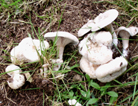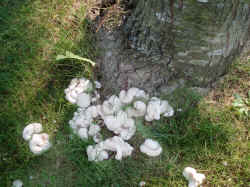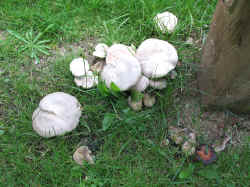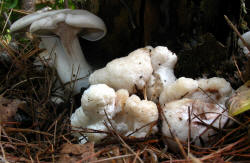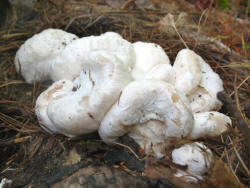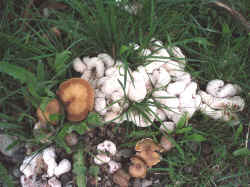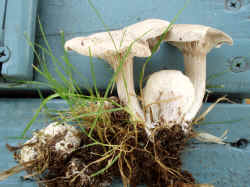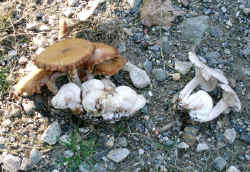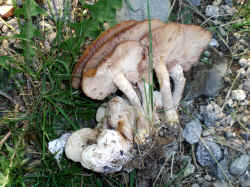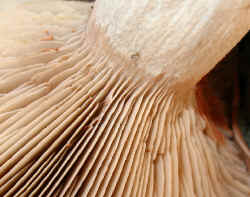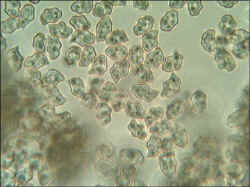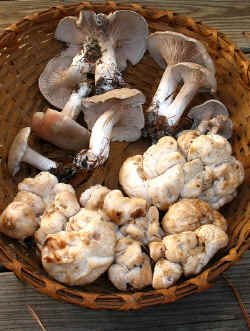|
|
Mushroom-Collecting.com A New England and Eastern Canada Edible and Medicinal Mushroom Resource |
|
Home
Chanterelle (Cantharellus cibarius) Black Trumpet (Craterellus cornucopioides, C. cenerius, C. foetidus) Small Chanterelles (Craterellus tubaeformis, C. ignicolor) Hedgehog (Hydnum repandum, H. umbilicatum) Horse and Meadow Mushroom (Agaricus arvensis, A campestris) Parasol Mushroom (Macrolepiota procera) Shaggy Mane (Coprinus comatus) (White) Matsutake (Tricholoma magnivelare) Blewit (Lepista nuda) Oyster Mushroom (Pleurotus ostreatus, P. populinus)
King Bolete (Boletus edulis) Boletus variipes and other. Two Colored Bolete (Boletus bicolor) Maitake (Grifola frondosa) Chicken of the Woods (Laetiporus sulphureus) Dryads Saddle (Polyporus squamosus)
Morels (Morchella esculenta, M. elata) Puffballs (Calvatia gigantea, Calvatia cyathiformis, others) Lobster Mushroom (Hypomyces lactifluorum) Aborted Entoloma (Entoloma abortivum)
Medicinal Mushrooms Maitake (Grifola frondosa) Reishi (Ganoderma tsugae, G. lucidum) Turkey Tail (Trametes versicolor) Chaga (Inonotus obliquus) Artist's Conk (Ganoderma applanatum)
Collecting, Photographing and
Cooking Collecting
Tips Evaluating
Flavor Dyeing Fabrics and Paper with Mushrooms
|
Aborted Entoloma The middle of September brings on the aborted Entoloma and it's intimately related companion the honey mushroom. This is one of my favorites to find. When found at the right time and correctly prepared they are excellent. This is one I have enjoyed for over 20 years. Although the rules for collecting say to avoid Entolomas, this is a special case since it resembles no other Entoloma. The aborted form has no gills. There is some controversy surrounding this mushroom and it's actual relationship with the honey mushroom (Armillaria mellea complex). Originally it was believed that honeys parasitize and deform the Entoloma. Now there are those that say the Entoloma parasitizes the Honey and that the deformed mushroom is actually a honey mushroom. I often wonder if this is something that could go either way depending on which mycelium is "stronger". I have found fruit bodies with two very different looks to them. This controversy is covered at MushroomExpert.com and I think the illustrations on that page show both examples. The fourth picture down by Richard Nadon is the more typical example while the sixth one down also by Richard Nadon looks to me more like an aborted honey mushroom. I have to say this is my personal speculation. I have no scientific proof. It's certainly possible that different types of honey mushrooms would abort differently. Honeys on conifer stumps predominate around my house and may be Armillaria ostoyae. Fruit bodies of both species were large and abundant in 2007. Tom Volk is a renowned mushroom scientist and he thinks they should be called Aborted Armillaria. He is likely to be right. Both the aborted and non-aborted forms are usually found together along with honey mushrooms. Occasionally honey's seem to not be much in evidence. Cap (pileus) 1-5 inch diameter gray or gray/tan convex cap round to somewhat kidney shaped with rolled in edges becoming flat or upturned with age. There can be a slight hint of pink. The aborted version is 1/2-4 inches, whitish, bumpy and usually depressed or folded at the center. The shape can be highly variable. Often it will have splits at or near the center. It can look somewhat like a puffball but is usually too deformed to closely resemble it. It can look folded or twisted and almost brain-like. The white color on the outside seems to rub off easily revealing some tannish tones. Gills/pores (hymenophore) Gills are grayish at first developing pink tones with age and run down the stalk a bit. Gills are not present in the aborted fruits. Stem (stipe) 1-4 inches long and 1/4 - 1/2 in thick with length usually roughly corresponding to cap width. It is often slight enlarged at the base. The aborted version is often short or almost stemless and usually somewhat brownish and striated or pithy inside. Flesh is whitish in the gilled version and fairly dense and meaty while the aborted version is somewhat pithy inside and can have pinkish tones. They may bruise slightly pink. Sometimes there are air spaces. There can be brown rot spots inside older ones where cracks in the cap have allowed water, dirt, or bugs to enter. These do absorb water readily and so require careful cleaning. Spores Pink to rouge in the non aborted gilled fruit. When and where to find them These are found mostly from mid September through October and coincide with the onset of heavy Armillaria growth. They are quite common. They are saprobic usually found around rotting wood, wood chips, stumps, or under older diseased trees growing around the roots. They seem to favor very rotten wood and are often found in lawns and parks and some woodland locations. They will be found in the same location year after year until the wood is consumed. They are most often in big bunches with the gilled version growing right with them or nearby. Expect to also see honey mushrooms. Preparation I have eaten the gilled version and they are quite good. For beginners they may be best avoided since they resemble other Entolomas which may be poisonous. Pick only the aborted fruits. There are usually more than enough when you find them so bypassing the gilled specimens is easy. These have a spotty reputation as an edible that I feel is undeserved. That said, they must be collected and cooked correctly. Look for fruits that are quite white, have few or no cracks in the top, and feel relatively dense (not spongy). Being a bit pithy on the inside is actually normal. Brown spots are a bad sign and waterlogged specimens are hard to cook. They are occasionally wormy so check closely for small white maggots. Once you get the idea of what the inside looks like you will not worry about these but you do not want to mistake them for early stage amanitas which can be deadly. Amanitas will have lines indicating a developing fruit and are much denser inside and smoother on the outside. Be very careful. Don't take a chance! Sometimes part of the fruit will be spoiling a bit while another part is quite nice. They often need some trimming. Cut the stem off. Clean them very carefully as they can hold bits of grit quite frequently. The pithy nature of the interior can cause them to absorb a lot of water. Don't let them get waterlogged. These are very good sautéed or pan fried but my rule is "cook them hard". I believe that their spotty reputation as an edible is due to undercooking. I like to cut them in half from side to side. When they are well browned and have most of the moisture cooked out and reclaimed they are best. That will reduce their size by more than half. They have a really nice nutty flavor. I like them a lot. Cooked incorrectly you may not. They are just OK deep fried. See my ratings page. You may have bad luck with these in a stir fry or with other mixing strategies unless they are the first item you cook or they are partially precooked before adding to the mix. The flavor is somewhat subtle so mixing with strong flavored foods may cause the flavor to get lost. I like them best pan fried/sautéed. Comments As with any species tried for the first time it is best to try a small bit first. When in doubt, throw it out! Beginning collectors avoid eating the gilled version. Entolomas can be very difficult to identify and other species of Entoloma can be very poisonous. The honey mushrooms that grow around them are edible for most people but these are probably best avoided too since some people have reactions to them. Armillaria is a complex rather than a single species making absolute identification fairly difficult. I have read that Armillaria growing around conifer stumps are more likely to offend. In any case, these are not for beginners. Generally, I don't eat honey mushrooms. With so much around to eat at this time of year, bypassing them is easy. I have tried them. Find more information here: Entoloma
abortivum at MushroomExpert.com
Use of this site will constitute your acceptance of the disclaimer. Copyright 2012 Mushroom-Collecting.com. All rights reserved. |
